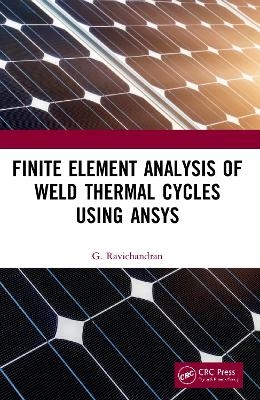
Finite Element Analysis of Weld Thermal Cycles Using ANSYS
CRC Press (Verlag)
978-0-367-51019-0 (ISBN)
Finite Element Analysis of Weld Thermal Cycles Using ANSYS aims at educating a young researcher on the transient analysis of welding thermal cycles using ANSYS. It essentially deals with the methods of calculation of the arc heat in a welded component when the analysis is simplified into either a cross sectional analysis or an in-plane analysis. The book covers five different cases involving different welding processes, component geometry, size of the element and dissimilar material properties. A detailed step by step calculation is presented followed by APDL program listing and output charts from ANSYS.
Features:
Provides useful background information on welding processes, thermal cycles and finite element method
Presents calculation procedure for determining the arc heat input in a cross sectional analysis and an in-plane analysis
Enables visualization of the arc heat in a FEM model for various positions of the arc
Discusses analysis of advanced cases like dissimilar welding and circumferential welding
Includes step by step procedure for running the analysis with typical input APDL program listing and output charts from ANSYS.
G. Ravichandran has had 37 years of experience with theWelding Research Institute which is affiliated to BHEL, Tiruchirappalli, India, and retired from WRI in 2017. His field of specialization is welding simulation using finite element method, prediction and control of distortion and residual stresses, design of static and fatigue loaded welded structures, experimental stress analysis etc. He obtained his PhD from Indian Institute of Technology, Madras in 1996 for his work on the “Analysis of axis shift distortion and residual stresses during circumferential welding of thin walled pipes”. He received the W H Hobart memorial award from American Welding Society in 1997 for his research paper “Prediction of Axis Shift Distortion during Circumferential Welding of Thin Pipes using the Finite Element Method”. He was a guest faculty for the National Institute of Technology during the years of service in WRI and handled classes for the post graduate program on welding engineering. After his retirement, he has joined NMAM Institute of Technology, Nitte, Karnataka as Professor Adjunct in Mechanical engineering department.
1. Introduction 2. Arc Welding Process 3. Thermal Cycles and Heat Flow in Welding 4. Finite Element Analysis 5. Arc Heat Model 6. Sample Problems 7. Conclusions
| Erscheinungsdatum | 04.08.2020 |
|---|---|
| Zusatzinfo | 56 Tables, black and white; 204 Illustrations, black and white |
| Verlagsort | London |
| Sprache | englisch |
| Maße | 156 x 234 mm |
| Gewicht | 476 g |
| Themenwelt | Technik ► Elektrotechnik / Energietechnik |
| Technik ► Maschinenbau | |
| Technik ► Umwelttechnik / Biotechnologie | |
| ISBN-10 | 0-367-51019-7 / 0367510197 |
| ISBN-13 | 978-0-367-51019-0 / 9780367510190 |
| Zustand | Neuware |
| Haben Sie eine Frage zum Produkt? |
aus dem Bereich


